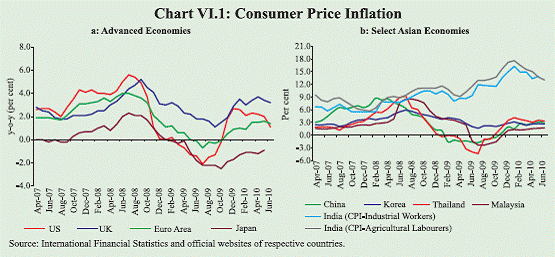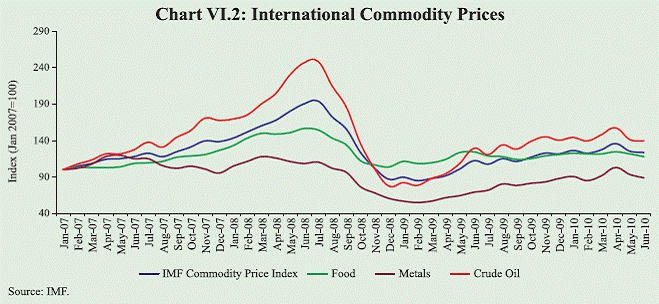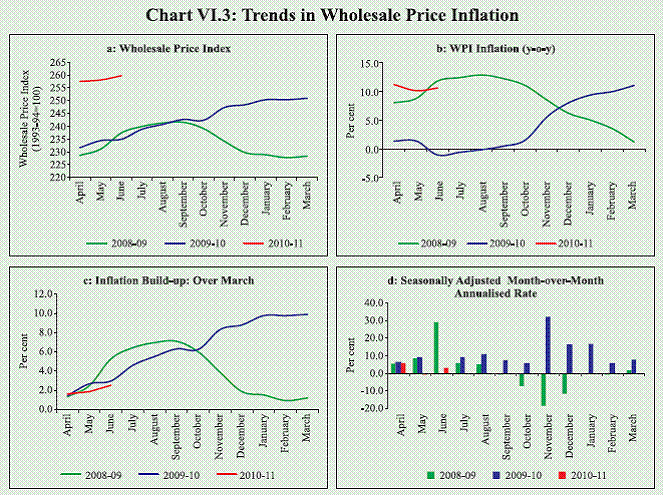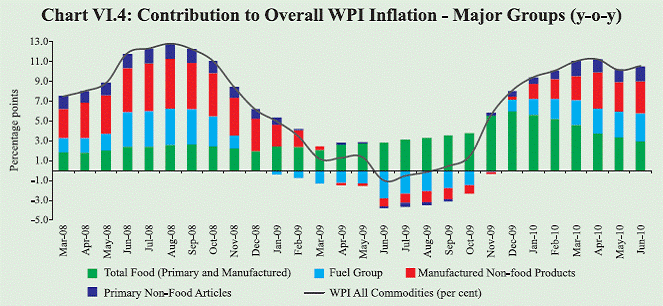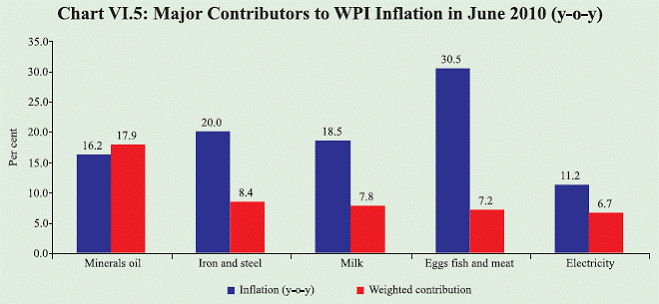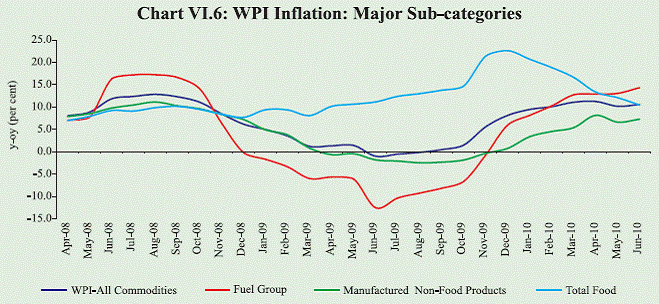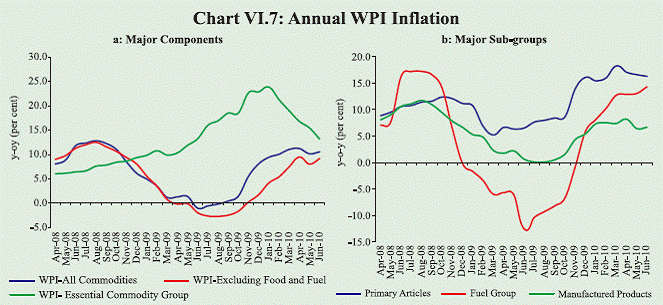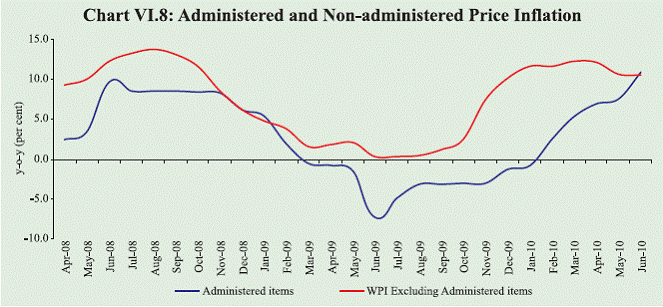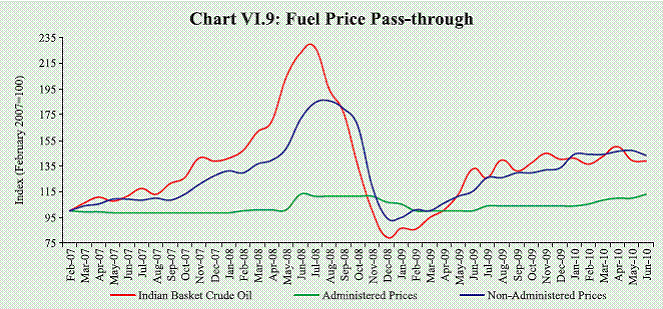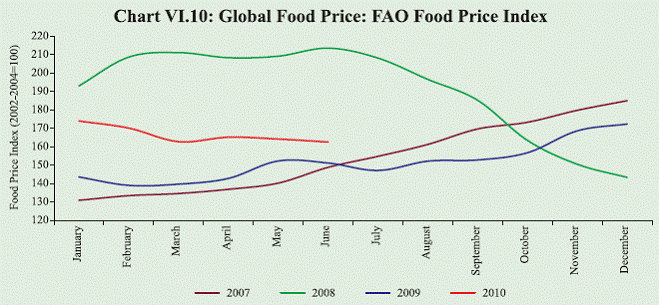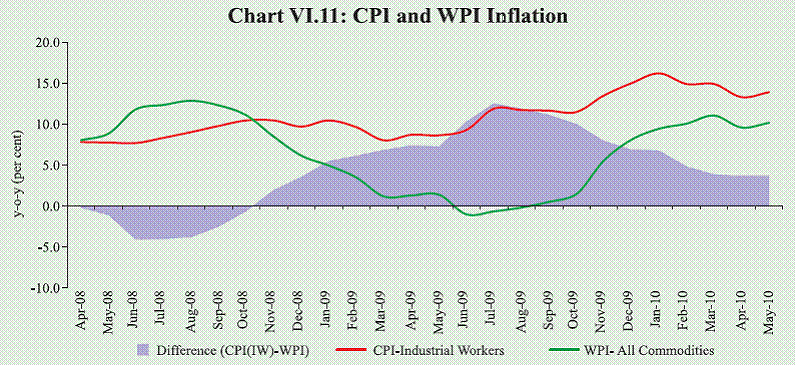VI. Price Situation - RBI - Reserve Bank of India
VI. Price Situation
The headline inflation has remained in double digits since February 2010, with increasing generalisation of price pressures over successive months. Food prices, the initial source of inflationary pressure, though moderated somewhat, still remain high. What has been particularly significant for the conduct of monetary policy is the manner in which nonfood manufactured inflation accelerated from near zero in November 2009 to 7.3 per cent by June 2010. Given the risks that high and persistent inflation could pose to the growth momentum as well as to the progress on inclusive growth, timely initiation of monetary policy measures to anchor inflation expectations and contain the inflation persistence has become essential. This is reflected in the Reserve Bank’s calibrated normalisation of monetary policy, since October 2009. VI.1 In the second half of 2009-10, the year-on-year WPI inflation increased significantly and reached 11.0 per cent by March 2010. What started as a supply side pressure on inflation led by high food prices in response to the deficient monsoon, became increasingly more generalised. In the first quarter of 2010-11, the headline inflation remained elevated in double digits, despite some moderation in prices of food products. Manufactured non-food products inflation further accelerated, indicating the strengthening of demand side pressures on inflation. Changes in administered prices as well as upward revisions in price indices that reflected lagged reporting of past price increases, contributed significantly to the increase in WPI in recent months. The decision of the Government to increase the prices of administered petroleum products and allow full pass-through of global crude price increases in the case of petrol in June 2010 is estimated to directly contribute about 0.9 percentage point increase to the WPI inflation immediately, apart from the indirect impact with a lag. Moderation in international commodity prices in recent months, following the downside risks to global growth from the euro area fiscal concerns, could ease some pressure on inflation. With a stronger recovery and consequent increasing demand side pressures, containing inflation expectations will remain as the highest priority for monetary policy during 2010-11. Global Inflation VI.2 The global inflation environment exhibited divergent trends, with the advanced economies still facing the risk of a possible deflation on the one hand and the EMEs starting to face the build-up of inflationary pressures on the other. Core inflation in advanced economies continues to remain subdued, indicating existence of large spare capacity. Despite well anchored inflation expectations, advanced economies have witnessed gradual increase in headline inflation since October/November 2009 from very low or negative levels during the first half of 2009. This was mainly on account of the waning of base effect of sharp decline in commodity prices that was recorded during the second half of 2008 (Chart VI.1 a). VI.3 Year-on-year consumer price inflation in OECD countries, which was negative during the period June-September 2009, increased to 2.0 per cent in May 2010. Core inflation (excluding food and energy) remained stable at around 1.5 per cent since June 2009, and declined to 1.3 per cent in May 2010 indicating absence of any pressure on inflation from the demand side. Core inflation in the euro area had declined in recent months, following the fiscal turbulence. A weaker euro, however, is expected to negate the possibility of a deflationary situation, even when private consumption demand remains relatively weak. VI.4 Emerging economies, on the other hand, face risks to inflation from both supply and demand sides. On the supply side, the significant increases in international commodity prices from their historic low levels recorded in early 2009 exerted pressures on inflation, notwithstanding the recent moderation in international commodity prices. The pressure from commodity price increase on inflation is more in the case of developing countries as their consumption baskets have larger shares of commodities, especially food and oil, unlike the advanced economies. As emerging economies exhibited stronger recovery and faster closing of output gap, risks to inflation from the demand side have also started to emerge. Moreover, stronger growth in emerging economies could also lead to further increases in demand for commodities, specially oil and metals, which in turn, could lead to additional increases in their prices internationally. Inflation in most of the emerging market economies increased in recent months (Chart VI.1b). VI.5 Concerns over recession and the subsequent fragile recovery were the major factors guiding the monetary policy stance adopted by most of the central banks in the advanced economies during 2009-10. Policy rates, accordingly, were left unchanged at near zero levels. During the second half of 2009-10, some inflationary pressures started to emerge, particularly in economies which witnessed faster than expected recovery and gradual closing of the output gap. This led to exit from crisis time easy monetary policy in those countries. The Reserve Bank of Australia and Bank of Israel have increased their policy rates by 150 and 100 basis points, respectively since September 2009. Greater uncertainty about the recovery, particularly since the escalation of fiscal concerns in the euro area, made most central banks in advanced economies to delay the increase in policy rates, except Bank of Canada which has raised the policy rate by 50 basis points since June 2010 (Table VI.1). Among the emerging economies, Brazil, Korea and Thailand have raised their policy rates since April 2010, and China has raised the reserve requirement ratio by a total of 150 basis points since January 2010. China has also taken measures to ease the overheating of asset prices.
Global Commodity Prices VI.6 International commodity prices started increasing in early 2009 and rebounded ahead of the global recovery, driven largely by the stronger growth impulses in EMEs and expected increase in demand, going forward (Chart VI.2). Since April 2010, however, some decline in commodity prices has been observed, as concerns over euro area recovery and sustainability of high growth in demand in emerging economies spilled over to commodity markets. VI.7 Crude oil prices had increased by about 70 per cent (year-on-year) in 2009-10. International crude prices have been volatile in recent months of 2010-11 tracking the uncertainties in global recovery. Crude oil prices declined about 11 per cent during April-June 2010. According to the World Bank, world crude oil demand is projected to record a growth of 1.9 per cent during 2010, with most of the incremental demand coming from the developing economies. Ample surplus capacity may, however, dampen any sustained pressures on oil prices. The IMF’s baseline projection for oil prices in 2010 has been revised downwards to US$ 75.3 per barrel in July 2010 from US$ 80 per barrel in April 2010. VI.8 Metal prices, which increased significantly during 2009 on account of strong demand, especially from China, moderated in recent months. International food prices, which were increasing gradually in 2009, led by few crops like sugar and coffee, declined in recent months. The FAO Food Price Index, a measure of the monthly change in international prices of a food basket comprising cereals, oilseeds, dairy, meat and sugar, increased significantly up to January 2010, and has declined since then by about 6.6 per cent up to June 2010. Major agricultural markets are expected to have sufficient supply during 2010, which could keep prices moderate over the medium-term. Inflation Conditions in India Wholesale Price Inflation VI.9 WPI year-on-year inflation, which remained moderate during April-May 2009 and subsequently turned negative during June-August 2009, increased at a fast pace to reach 11.0 per cent by March 2010 and remains elevated since then (10.6 per cent in June 2010) (Chart VI.3 a and b). The WPI has exhibited sustained increase since February 2009, indicating secular pressure on prices (Chart VI.3 c). This is also corroborated by positive month over month seasonally adjusted annualised inflation (Chart VI.3 d). VI.10 The WPI inflation continues to remain high at double digits since February 2010, though there have been shifts in the contributors and the relative strength of each item in the WPI basket to inflation. The contribution of food inflation to overall inflation declined from above 100 per cent in December 2009 to about 28 per cent in June 2010. The contributions of the fuel group and the non-food manufacturing group increased with more or less equal weighted contribution of each, suggesting increasing generalisation of the inflationary pressures (Chart VI.4). VI.11 The current inflationary pressures initially originated from the supply side on account of the shortfall in agricultural production and gradually increasing international commodity prices. With increasing generalisation, the food items as a key driver of inflation has now been replaced by fuel and metals. Commodities like milk, egg, fish and meat continue to have high inflation (Chart VI.5) VI.12 Divergence in inflation across different sub-groups within the commodity groups posed significant challenges in assessing the underlying inflationary pressures during 2009-10. Supply shock dominated divergence should normally remain temporary. Inflation across different sub-groups, after witnessing considerable divergence, have exhibited some convergence in recent months. The decline in food inflation (specially in manufactured food products, led by sugar) along with increase in non-food inflation have led to closing of the gaps between inflation across different commodity groups (Chart VI.6). VI.13 Inflation in essential commodities group, which increased sharply during the major part of 2009-10, has moderated since January 2010 (Chart VI.7a).The y-o-y WPI inflation, excluding food and fuel, though increased significantly in recent months, continues to remain below the headline inflation. The trend of non-food non-fuel inflation, a rough measure of core component, however, has moved in sync with the headline inflation. VI.14 A major part of the increase in inflation in recent months could be attributed to a number of changes in administered prices of several products. With upward revision in administered prices, the suppressed inflation became more open, leading to increase in overall inflation (Chart VI.8). Between November 2009 and June 2010, WPI has increased by about 5.1 per cent, and changes in administered prices and lagged reporting of earlier increases in prices have contributed as much as 42 per cent of the increase in WPI (Table VI.2). The full impact of the revision in administered prices of petroleum products effected in June 2010 will be reflected largely in WPI for July 2010. VI.15 Amongst the major groups, primary articles inflation, y-o-y, has increased significantly since October 2009, mainly on account of food prices, which registered high double-digit increase (Chart VI.7b). Some softening of inflation in primary articles is visible in recent months reflecting the seasonal moderation in prices of food articles. The moderation in food inflation in June 2010 partly reflected the base effect. Primary articles inflation had increased significantly in March 2010 as sugarcane price index was revised upwards by about 50 per cent after keeping almost unchanged for two years and thus reflected the effect of lagged reporting of past increases in prices. The y-o-y inflation in primary articles as on July 10, 2010 was 16.5 per cent. VI.16 Year-on-year fuel group inflation turned positive in December 2009 reflecting the base effect of downward revision to administered prices effected in December 2008. The reversal of customs and excise duty concessions given on petroleum products in the Union Budget for 2010-11, as part of the fiscal exit, and increases in taxes of petroleum products by certain state governments, led to increases in administered prices of petroleum products. Freely priced products under the minerals oil group usually track the trends in international crude prices (Chart VI.9). A significant gap in the administered prices of petroleum products in relation to the price of Indian basket crude oil (converted to rupees at respective monthly average exchange rates) increased the underrecoveries of oil marketing companies and the burden on the fiscal situation. As the consumption growth of petroleum products is also expected to pick-up with increase in growth momentum, the fiscal burden could have increased further, even with stable international prices. Motivated by fiscal as well as fuel efficiency considerations, the Government increased the price of diesel (by Rs.2 per litre), PDS kerosene (by Rs.3 per litre) and domestic LPG (by Rs.35 per cylinder) and deregulated petrol prices on June 25, 2010. The direct impact of these measures are expected to cause about 0.9 percentage point increase in WPI inflation, with the indirect impact on prices through input cost escalation with a lag likely to raise the full impact to about 2 percentage points, assuming partial pass-through. The WPI inflation figures for June 2010 reflects only part of the direct impact. As on July 10, 2010, the y-o-y fuel group inflation was at 14.3 per cent. VI.17 Manufactured products inflation, year-on-year, though remains lower than food and fuel inflation, has increased since August 2009 and was at 7.4 per cent in March 2010, driven by inflation in manufactured food products. Since then, manufactured food inflation has declined to 4.3 per cent in June 2010 from 15.5 per cent in March 2010, led by lower inflation in sugar and decline in edible oil and oil cakes prices. Manufactured non-food products inflation, however, accelerated from -0.4 per cent in November 2009 to 7.3 per cent in June 2010 (Table VI.3). VI.18 Domestic price trends in several commodities have been quite different from corresponding international trends (Table VI.4). Despite decline in inflation in recent months in several food items internationally, their prices have not come down to levels that were prevailing in the pre-global crisis period. This suggests why import as an option for domestic price control is still not available to India for several essential items (Chart VI.10). Consumer Price Inflation VI.19 Inflation, as measured by various consumer price indices, has exhibited some moderation since January 2010 as food price inflation witnessed some softening. CPI inflation, however, remained high in the range of 13.0-14.1 per cent during May-June 2010 (Table VI.5).
VI.20 The divergence between WPI and CPI inflation reduced in recent months as CPI inflation declined moderately in recent months while WPI inflation increased significantly (Table VI.5 and Chart VI.11).
VI.21 Overall, the inflationary process, which originated from supply shocks, has now become generalised. Changes in administered prices and lagged reporting of past price increases have added force to the uptrend in WPI in recent months. Given the expected better kharif output than last year, food price pressures may moderate during the course of the year. Non-food manufactured products inflation, at 7.3 per cent, is above the comfort level. Along with the observed inflation persistence, emerging demand pressures could add to inflation expectations. Wage revisions to offset the impact of inflation on purchasing power, and use of higher mark ups with return of pricing power of firms, could strengthen the interactions between inflation expectations and actual inflation. This suggests a need to continue the process of normalisation of monetary policy to anchor inflation expectations. |
||||||||||||||||||||||||||||||||||||||||||||||||||||||||||||||||||||||||||||||||||||||||||||||||||||||||||||||||||||||||||||||||||||||||||||||||||||||||||||||||||||||||||||||||||||||||||||||||||||||||||||||||||||||||||||||||||||||||||||||||||||||||||||||||||||||||||||||||||||||||||||||||||||||||||||||||||||||||||||||||||||||||||||||||||||||||||||||||||||||||||||||||||||||||||||||||||||||||||||||||||||||||||||||||||||||||||||||||||||||||||||||||||||||||||||||||||||||||||||||||||||||||||||||||||||||||||||||||||||||||||||||||||||||||||||||||||||||||||||||||||||||||||||||||||||||||||||||||||||||||||||||||||||||||||||||||||||||||||||||||||||||||||||||||||||||||||||||||||||||||||||||||||||||||||||||||||||||||||||||||||||||||||||||||||||||||||||||||||||||||||||||||||||||||||||||||||||||||||||||||||||||||||||||||||||||||||||||||||||||||||||||||||||||||











